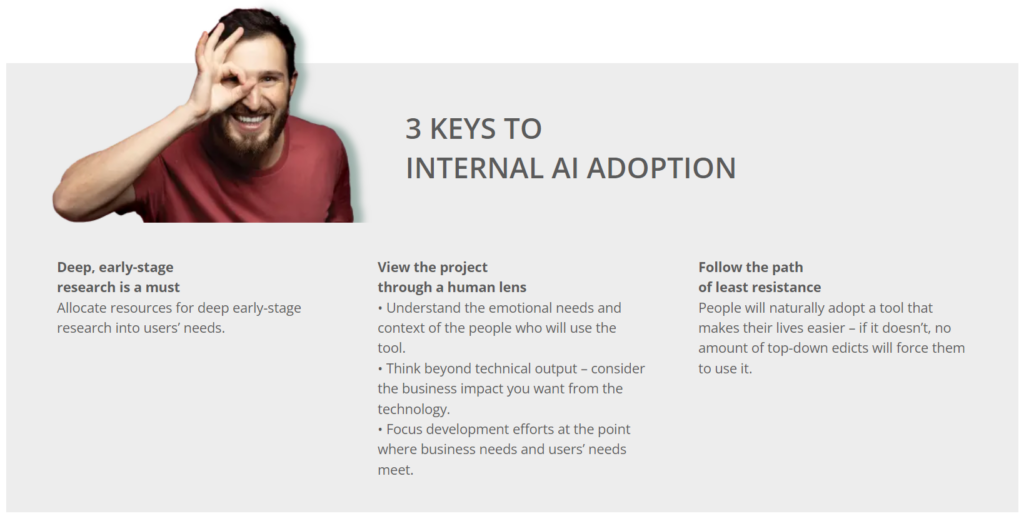Enterprise artificial intelligence (AI) investment is accelerating fast. For instance, in its latest CIO and Technology Executive Survey, Gartner predicts global revenue will reach $62.5 billion in 2022, increasing more than 21% from 2021. Enterprises are driving that growth, with 48% of CIOs saying they have already deployed AI and machine learning or plan to do so in the next 12 months.
However, ensuring the adoption of those new tools can be another matter. Gartner also points out that while enterprises are keen to experiment with AI, many struggle to establish the technology as part of their standard operations. It lists reluctance to embrace AI, lack of trust in the technology, and difficulties delivering business value from AI investments among the causes.
Behind those figures lies a fundamental reality: enterprises invest millions of dollars in developing AI business tools. Once they’ve deployed those tools, many discover that most of their people are not using them. And no tool can deliver value if people don’t use it.
So, where are all those good intentions going astray? In most cases, the issue can be traced back to early assumptions about what users really need.
“People often assume they know their teams well, so when developing new AI tools, they don’t research internal user’s needs as rigorously as they would for an external client, “says Benis Kumar Moses, Director, Experience team at Fractal. “That assumption leads to early-stage mistakes, which proliferate during development and are eventually built into the finished product. Poor adoption is the result. Without a full understanding of how the technology meets the needs of its users, enterprises are planning their AI projects to fail despite their good intentions.”
Even when enterprises realize a problem, their assumptions about user’s needs often prevent them from resolving the issues early on. Many enterprises assume that a better user interface, training program, or awareness-raising exercise will get more people using their new AI tool–but those theories are usually wrong. Only rigorous research can reveal the root cause of poor adoption and the steps needed to resolve it. That means going right back to the project’s discovery phase and engaging with stakeholders to get a deep understanding of their needs.
It can be a costly lesson for many enterprises to learn. But applying a few simple principles to AI development can help them drive internal adoption and maximize the value of their investment.
Resourcing deep, early-stage research is a must. Still, while this is common practice for external-facing AI projects, it’s often overlooked when developing tools for internal users. Typically, internal enterprise AI projects are developed by the IT, HR, and administrative departments–none of which have the research team, design team, or budget to understand user needs before they start building products fully. After all, if internal users are unhappy with the tools they’re given to do their job, that will spoil the experience for their customers.
It’s also crucial to think beyond the new tool’s technical output. An enterprise that is focused entirely on developing an AI algorithm to improve customer segmentation, for example, can inadvertently blind itself to the real problem it needs to solve. Key questions about why the enterprise wants to build that tool can help to reframe the issues. For instance, if the sales team isn’t using the current segmentation tool, why is that happening? Perhaps they have their way of segmenting customers and have no interest in using a segmentation tool. If that’s the case, the segmentation algorithm isn’t the problem. Behavior change is the issue that needs to be addressed, and better segmentation is just one aspect of that. By reframing the problem, the focus turns to understanding what matters to the sales team. Identifying their needs and helping them improve the way they segment customers–and then translating that into actions, including a better way of defining segmentation.
Ultimately, the successful adoption of enterprise AI starts with putting the human being at the heart of the problem.
After all, scientific evidence indicates that people’s choices are based on emotions in the ‘hot’ state of decision-making. When the person wants to justify those decisions, rational factors come into play later.
A traveling salesperson, for instance, lives a life of uncertainty because finishing a job or closing a deal all depends on their client’s response. They spend most of their day in the field, waiting outside client’s offices with all their sales collateral in the boot of their car. While they wait, they may be worrying about how to close a deal in time for the quarterly bonus or how to juggle their work and childcare commitments. The technical output or business value of the new app they’ve been asked to use is the least of their priorities; however, if the app helps them achieve that bonus and strike that work-life balance, they’ll pick it up.
Of course, the tool needs to create value for the business, too. But to do that successfully, it’s crucial first to understand the user’s context, emotions, and motivations. It’s a simple equation: if the tool makes user’s life easier, they will adopt it; if it doesn’t, they won’t.
“For the technology to deliver real value, the problem it’s intended to solve must be framed at the intersection of the enterprise’s need and the user’s need”, says Francesca Passoni, Principal Consultant, Experience team, at Fractal. “That will avoid the need for top-down directives such as pushing people into training programs or introducing incentives to drive adoption. These strategies are often bolted on after deployment, and they don’t work in the long term. Instead, look at the success of technology like Apple’s touchscreen devices: they don’t require a training manual or awareness-raising exercises because they deliver intuitive value for users.
Enterprise AI tools enable human decision – making in the enterprise , not replace it, and they should be just as simple and intuitive for users to adopt.
Fundamentally, design thinking and behavioral science is about looking through human eyes and putting aside any preconceptions from a business, technology, or organizational perspective. Those perspectives are important, but they come later–it’s important to first look at the issue through a human lens.”
3 KEYS TO INTERNAL AI ADOPTION
Deep early-stage research is a must
View the project through a human lens
Understand the emotional needs and context of the people who will use the tool
Think beyond technical output–consider the business impact you want from the technology
Focus development efforts at the point where business needs and user’s needs meet
Follow the path of least resistance. People will naturally adopt a tool that makes their lives easier–if it doesn’t, no amount of top-down edicts will force them to use it.








